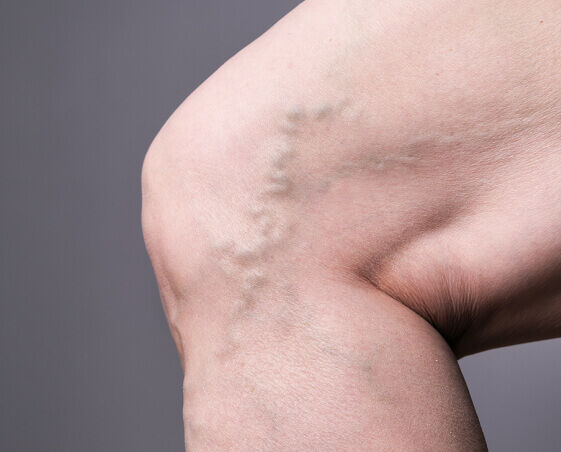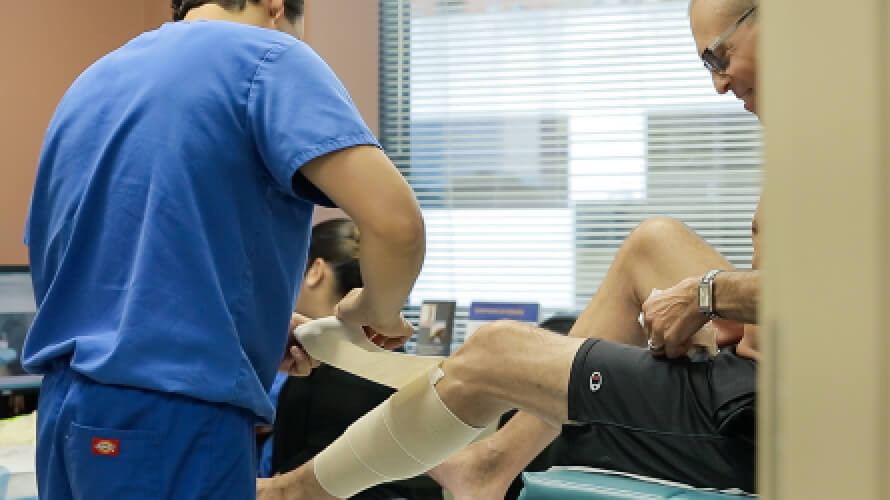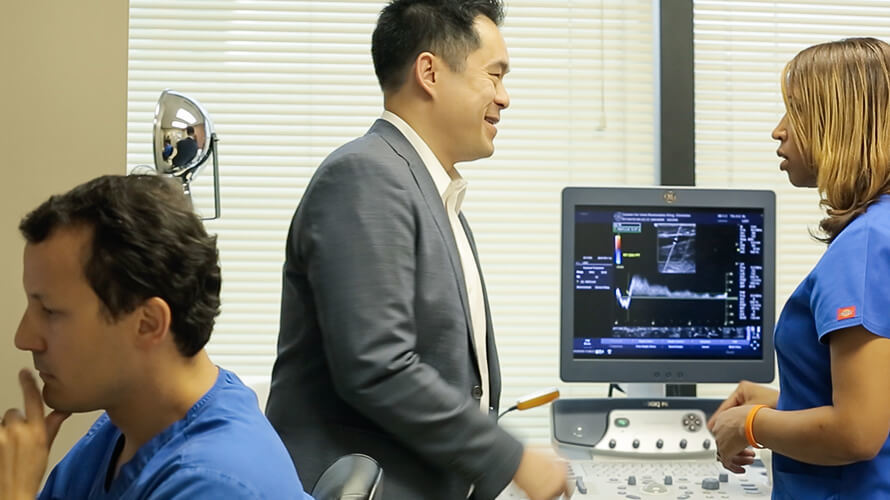Varicose Veins: Causes, Symptoms, and Treatment
Are you living with vein disease?
If you have venous insufficiency (vein disease), you understand the leg pain, swelling, aching, cramping, feelings of heaviness, and telltale twisted or bulging purple or blue leg veins. If you’ve been living with untreated vein disease long enough, you may have developed complications such as skin discoloration, leg ulcers, or a blood clot in the leg.
Click below to learn what varicose veins are, what causes varicose veins, the risk factors, the symptoms to look out for, and the treatment options for varicose veins.

Day one through two weeks post-vein procedure
Immediately after the vein procedure
- You may resume normal day-to-day activities immediately but do expect some discomfort and bruising along the treated vein. This usually resolves within 1-2 weeks. Lighter activity levels may be necessary for the first 48 hours after phlebectomy.
- Take 400mg of Ibuprofen every 6-8 hours with food for pain relief. If you’re unable to take Ibuprofen, Tylenol (up to 500mg every 12 hours) is recommended. If you have severe pain (for example, you can't sleep or walk) that is unresponsive to the recommended pain relievers, contact our office.
Days after your vein procedure
- To minimize infection risk, we prioritize sterile conditions during our procedures. Although the chance of infection is extremely low, we advise avoiding pools, hot tubs, or bathtubs for 7-10 days after the procedure. Showering is acceptable, but please wait 24 hours before removing the applied ace wrap.
- To allow for proper healing, we advise you to wait 7-10 days before returning to exercising, such as running, weightlifting, or cycling. Avoid lifting anything over 20 lbs. during this time. Refrain from any vigorous activity and weight-bearing exercises that strain the legs and arms, as they can exert excessive force on the healing vein and potentially reopen it. Instead, opt for a modified workout such as walking or using a treadmill.
Weeks after your vein procedure
- Some patients may notice a temporary decrease or loss of sensation in the treated area, particularly along the shin bone and ankle. This is a result of nerve irritation and will gradually improve as the healing process progresses.
- Feeling a sense of tightness or pulling along the treated vein is normal and anticipated. Before the procedure, the veins are flexible, but after treatment, they contract and transform into scar tissue, often resulting in a cord-like sensation. This sensation may emerge over 1 to 4 weeks after treatment and gradually diminish over time.
- The closure of the treated vein can trigger an inflammatory response in the treatment areas, and it may appear red, swollen, tender, and warm to the touch. This usually occurs within one week after laser or radiofrequency ablation or 3 to 6 weeks after foam sclerotherapy treatments.
- Experiencing hardened, tender knots in the treated areas, especially after an ambulatory phlebectomy, is a normal occurrence. Referred to as "trapped blood," it happens when blood is confined, and forms clots within the treated vein. While not typically dangerous, these areas can be tender and warm. To alleviate discomfort and aid in healing, applying warm, moist compresses and gently massaging the area multiple times a day is recommended. This promotes natural reabsorption. If needed, a thrombectomy procedure can provide immediate relief by removing the trapped blood through a small incision under local anesthesia. If you notice severe pain, fever, increased swelling, or redness associated with warmth in the leg, please contact us.
- Skin discoloration can occur when the treated vein is located near the skin's surface. After treatment, the skin absorbs byproducts from the blood, resulting in staining. This discoloration will gradually fade over time during the healing process, but it may take several months, especially for larger veins.
- Some veins may require multiple treatments to disappear completely. During the one-month follow-up, we will assess these veins to determine if additional treatment is necessary. In some cases, insurance coverage may include additional visual sclerotherapy sessions. If not covered, your Center for Vein Restoration vein doctor will discuss other options with you.
First five months after your vein procedure
- You will have a one-month post-procedure follow-up scan, and the findings discussed during a consultation. This ultrasound study may reveal new findings because venous insufficiency is a chronic condition. The need for further treatments may be addressed during this visit.
- As the healing process continues, you can expect ongoing improvement in your treatment outcome. It is common to experience some lingering swelling, but it should gradually diminish over the next 3-6 months.
- It is normal to experience a lingering "tight" sensation in the treated vein during this stage of the healing process. However, this sensation should gradually diminish over time.
- While there may still be residual knots or trapped blood areas, you will notice a decrease in tenderness in the treated area. This is a normal part of the healing process. Continuing to apply warm compresses and gentle massages, as previously recommended, can help alleviate discomfort and promote healing.
Six months after your vein procedure
- By this stage of the healing process, the majority of patients notice a significant reduction or complete resolution of any lingering symptoms from the procedures, including numbness, discoloration, and hardened areas.
- If you notice any worsening of symptoms or experience new ones, such as increased aching pain, swelling, heaviness, or fatigue, we strongly advise scheduling a follow-up appointment. These changes could indicate that your underlying venous disease may require further treatment.
One year after vein treatment
Venous insufficiency is a chronic and progressive condition, and while we address the refluxing veins initially, other veins may eventually become dysfunctional over time. To ensure comprehensive care, we offer surveillance and monitoring services. We recommend reevaluations at the one-month, six-month, and one-year marks after the procedure. After the first year, annual follow-up appointments are necessary. If you experience new or worsening symptoms at any point, please contact our CVR office to schedule an evaluation.
Post-procedure care for laser & radiofrequency treatments
Although the healing time for laser and radiofrequency treatments is minimal, we do advise following several steps after your procedure to ensure there are no complications with your recovery.
- Avoid prolonged sitting or standing. If sitting for more than three hours (while traveling, for example), prioritize getting up and moving around at least every hour. Speak to your doctor about using baby aspirin.
- It's normal to experience some tenderness and possibly some bruising along the areas where local anesthesia was administered.
- Refrain from strenuous activities and heavy lifting for two weeks.
- You may shower, but no tub baths, swimming, or hot tubs for the first week.
- Compression stockings will help with the closure procedure; wearing them for three days after the procedure is mandatory. The more you wear them, the better you'll feel. You can take them off at night, however.
- While rare, bleeding through the bandages may occur. Lie down, elevate your leg, and apply direct pressure until the bleeding has stopped. If the bleeding persists, please call your CVR physician.
- Schedule your follow-up Duplex (ultrasound) scan within 3-7 days after your procedure.
Post-procedure care for ultrasound-guided foam sclerotherapy
Like laser and radiofrequency treatments, the healing process for ultrasound-guided foam sclerotherapy is easy. With that being said, it's still extremely important to follow our post-procedure instructions to have the best vein care experience possible.
- Wear your compression stockings at all times for the first three days. Compression will promote clearance of the medication in the vein and reduce straining. You may remove them temporarily to shower, however.
- Soothing aloe vera gel or cool packs may be used to ease discomfort. Tylenol or ibuprofen may also reduce any post-treatment irritation. However, please avoid using aspirin.
- After the first three days, continue to wear your compression stockings daily except for showering and sleeping for two weeks. Following this period, they may be worn at your discretion.
- Avoid very hot showers and avoid tub baths, hot tubs, and swimming for one week. Pat the skin dry after showering.
Post-procedure care for ambulatory phlebectomy
Walking after this procedure is encouraged. Keep your post-operative bandage in place for 24 hours before replacing it with daytime compression stockings for the next 1-2 weeks. Recovery time is immediate; however, temporary bruising or swelling may occur after the procedure. Because they heal quickly, the small slit-like incisions made during an ambulatory phlebectomy should be practically invisible after 6-12 months.
Post-procedure care for visual sclerotherapy
After undergoing visual sclerotherapy injections, it is important to wear a compression stocking to support the closure of the treated vein. However, you can resume your normal daily activities right away without any delay. Talk to your Center for vein Restoration physician about any restrictions.

